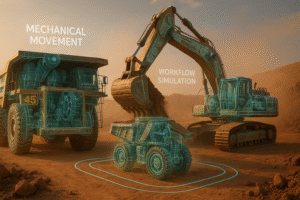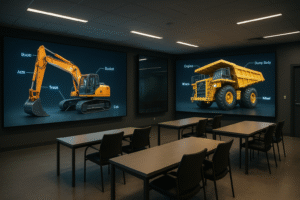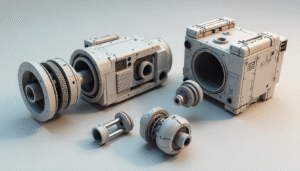E-commerce is evolving rapidly, and one of the most exciting advancements shaping its future is 3D visualization. This technology is transforming how consumers interact with products online, bridging the gap between physical and digital shopping experiences. As online shopping grows, the demand for immersive and interactive product displays is at an all-time high.
With the rise of augmented reality (AR) and virtual reality (VR), businesses are adopting 3D technology to offer more engaging, accurate, and immersive shopping experiences. Customers can now rotate, zoom, and even personalize products before making a purchase, increasing buyer confidence and reducing return rates.
This article explores the rise of 3D visualization in e-commerce, key technologies driving its adoption, its benefits and challenges, and future trends that will define the industry in the coming years.
The Rise of 3D Visualization in E-Commerce
Traditional product images and videos are no longer enough to satisfy today’s online shoppers. Consumers want a realistic, hands-on experience before committing to a purchase, and 3D visualization provides just that. By allowing customers to explore products from every angle, zoom in on details, and interact with them in real-time, 3D technology is revolutionizing product presentation.

Why is 3D Visualization Gaining Popularity?
- Enhanced product experience: Shoppers can rotate, zoom, and interact with products, mimicking the in-store shopping experience.
- Increased confidence: 3D models provide a clearer understanding of the product before purchase, reducing uncertainties.
- Reduced return rates: More accurate product representations help minimize buyer’s remorse and unnecessary returns.
- Personalization and customization: Many e-commerce platforms now allow users to customize colors, textures, and sizes of products in 3D before buying.
- Integration with AR and VR: Customers can visualize products in their actual environments, such as furniture in a room or clothing on their bodies.
Brands Leading the Way in 3D E-Commerce
Many top-tier brands have already adopted 3D visualization:
- Nike uses 3D models for customizable shoes, allowing customers to modify colors, textures, and designs before purchase.
- IKEA integrates AR-driven 3D models to let customers visualize furniture in their homes via its IKEA Place app.
- Apple displays its latest devices in stunning 3D interactive formats, enabling users to examine intricate details.
- Amazon has introduced View in Your Room, allowing shoppers to place digital 3D furniture models in their living spaces before buying.
These brands have set the stage for the widespread adoption of 3D visualization, proving that it can enhance both the customer experience and conversion rates.
Key Technologies Driving 3D Visualization
Several cutting-edge technologies are fueling the growth of 3D visualization in e-commerce:
Augmented Reality (AR) and Virtual Reality (VR)
- AR lets shoppers place digital products in real-world settings (e.g., trying on glasses or makeup virtually).
- VR creates immersive shopping experiences, allowing users to walk through virtual showrooms and interact with products as if they were in a physical store.
- Meta, Snapchat, and Instagram are integrating AR shopping tools, enabling users to try products within social media apps before purchasing.
Artificial Intelligence (AI) and Machine Learning
- AI enhances 3D model generation by automating texture creation, realistic rendering, and personalization.
- Machine learning helps personalize recommendations based on user interactions with 3D models, improving product discovery.
- AI-driven chatbots can assist users in navigating 3D shopping environments and answering product-related questions.
Web-Based 3D Rendering & Cloud Computing
- WebGL enables seamless browser-based 3D rendering without the need for plugins, improving accessibility.
- Cloud-based rendering allows faster and more scalable 3D experiences across devices, ensuring smooth performance on mobile and desktop.
- 5G technology will further enhance 3D content delivery speeds, reducing lag and improving interactivity.
The Benefits of 3D Visualization in E-Commerce
Increased Customer Engagement & Conversions
Interactive 3D models create an engaging shopping experience, leading to higher conversion rates. Studies show that customers who interact with 3D products are more likely to complete their purchases compared to those viewing static images.

Lower Return Rates
By offering a more accurate representation of products, customers know exactly what to expect, reducing dissatisfaction and returns. Retailers using 3D visualization have reported a 30-50% reduction in return rates.
Better Mobile Shopping Experiences
With more consumers shopping via mobile, responsive 3D models ensure a smooth experience on all screen sizes. AR features integrated into mobile shopping apps further enhance usability.
Higher Customer Satisfaction & Brand Loyalty
Brands that offer an immersive and interactive shopping experience stand out from the competition. The ability to customize products in 3D increases customer satisfaction and encourages repeat purchases.
Challenges in Implementing 3D Visualization
High Development Costs
Creating high-quality 3D assets requires specialized tools and expertise, which can be costly. However, advancements in AI-driven model generation are making the process more affordable.
Performance & Loading Speed Issues
Large 3D files can affect website speed, leading to poor user experience. Optimization strategies like lazy loading, compressed textures, and cloud rendering help mitigate this issue.
Technical Expertise & Integration Hurdles
Not all platforms support seamless 3D integration, requiring businesses to invest in custom development or third-party solutions.
Emerging Trends in 3D Visualization for E-Commerce
AI-Generated 3D Models
AI-driven automation is revolutionizing the 3D model creation process, reducing costs and time required to generate realistic product visuals.
3D & AR Integration with Social Commerce
Platforms like Instagram, TikTok, and Pinterest are exploring 3D shopping experiences, allowing users to interact with products directly within social media apps.
The Future of Virtual Shopping Showrooms
E-commerce giants are experimenting with virtual stores, where customers can browse products in a fully immersive digital environment using VR headsets.
Predictions for the Next 5 Years
- Mass Adoption of 3D Shopping: More businesses will integrate 3D product visualization as costs decrease and technology advances.
- AI-Driven Customization: AI will enable real-time, personalized 3D product configurations, allowing users to tailor items to their preferences.
- Widespread Use of AR/VR in E-Commerce: Retailers will leverage AR/VR for an enhanced online shopping experience, making digital shopping feel more tangible.
- More Affordable 3D Content Creation: AI and automation will make high-quality 3D models accessible even to small businesses.
- Seamless Integration with Mobile Apps: Expect deeper integration of 3D and AR experiences in e-commerce apps, making online shopping more interactive than ever.
How Businesses Can Prepare for 3D E-Commerce
Steps to Implement 3D Product Visualization
- Choose the right tools: Platforms like Shopify, WooCommerce, and Magento now support 3D models.
- Partner with 3D content creators: Work with professionals to create high-quality, optimized 3D assets.
- Ensure cross-platform compatibility: Optimize 3D content for desktop, mobile, and AR experiences.
- Test performance & usability: Ensure fast loading speeds and smooth interactivity to enhance user experience.
Conclusion
3D visualization is more than a passing trend—it’s transforming the way e-commerce businesses engage customers. Companies embracing interactive, immersive shopping experiences powered by AI and AR technologies will consistently outpace their competitors. Don’t get left behind; elevate your brand by investing in stunning, personalized 3D visuals that captivate your audience and secure your place in the future of e-commerce.
FAQs
Q1: How does 3D visualization improve e-commerce sales?
3D models allow customers to see products from every angle, leading to higher engagement and increased trust, which results in higher conversion rates.
Q2: Is 3D product visualization expensive to implement?
While initial costs can be high, advancements in AI-driven 3D modeling and cloud-based rendering are making it more affordable for businesses of all sizes.
Q3: What are the best platforms for 3D e-commerce integration?
Popular platforms include Shopify (with AR & 3D support), WooCommerce, and Magento .
Q4: How does 3D technology reduce return rates?
Accurate product visualization helps customers make informed decisions, reducing mismatched expectations and returns.
Q5: What are the future advancements in 3D e-commerce?
Future developments include AI-powered 3D customization, real-time AR shopping experiences, and fully immersive virtual stores.






